Feeling your traditional project management methods don’t work as intended? Want to learn how to implement Scrum to deliver results faster and adapt to changing needs on the fly? We’ll help you!
Scrum is a flexible framework that lets you build your project in short bursts, get constant feedback, and adjust to the needs of your project as they change. It can be a game changer for businesses of all sizes. Quicker product launches, happier clients, and a more productive team are just some of the benefits the Scrum framework offers.
Now, how does Scrum actually work?
The Scrum Process
- It begins with what we call a product roadmap, which is a plan that details what you want to build. It is a flexible roadmap that changes as you gain feedback and ideas.
- Once you have your roadmap, the next step in Scrum is to break down your big plan into smaller, manageable pieces called “sprints.” Each sprint is one to four weeks long and contains a small set of features that your team focuses on.
- Next, the team has daily check-ins where each member details their previous day’s work and any obstacles they faced.
- At the end of a sprint, there is a sprint review where you check out the new features and the progress so far.
- Then comes the Sprint Retrospective. Your team answers questions like, ‘What went well?’ and ‘What could be better?’
- After the review and retrospective, you start another sprint and repeat the process. You repeat the process until you feel the product meets the goals set out in the roadmap.
- The final phase involves final testing, bug fixing, and preparing the product for launch.
And there you have it—a straightforward run-through of implementing Scrum from start to finish. Ready to learn how to get started with Scrum in your projects?
Preparation for Scrum Implementation
Scrum is a great approach to managing software development projects. Before you learn how to implement Scrum, it’s important to understand a few concepts that will make your journey smooth.
Difference Between Agile and Scrum
Agile and Scrum are often used interchangeably. But there’s a subtle difference between them.
- Agile is a methodology that is about flexibility and adaptability to changes in managing projects. It deals with quick iterations and changes on the go in product development.
- Scrum is a specific framework within Agile that breaks down this methodology into clear, actionable steps your team can take.
Agile is a mindset while Scrum is the set of steps to put that mindset into action.
As you implement Scrum in your agile project development, consider partnering with Codewave. Our team is here to help you streamline your project development process using design thinking so that every sprint is effective and aligns with your goals.
Importance of Having a Vision
Before jumping into the daily Scrum sprints, take a moment to set the vision for your product. You might already have a product vision in your mind. Consider questions such as, ‘What is your product going to achieve?’ and ‘Who is it for?’
This vision will keep every member of the project motivated and moving in the same direction. Without a clear vision, you may not even get to the final product.
Building the Right Team
Scrum thrives on collaboration, so having the right people on board is helpful. You’ll need three key players:
- Product Owner: The product owner is like the voice of the customer within your team. They prioritize the work to be done based on what will bring the most value to customers.
- Scrum Master: Think of a Scrum master as the team’s coach. They make sure everyone follows the best Scrum practices and see to it that all roadblocks are removed so the team can work efficiently.
- Development Team: These are the coders, designers, testers, etc., who actually build the product and get the actual work done during each sprint. Developers work together to bring the vision to life.
The product owner is in charge of the product backlog – nothing gets done without their permission. Scrum master focuses on the process and makes sure meetings are timely and productive. The development team should have a clear knowledge of their tasks.
So, you’re prepared to implement Scrum and have a clear vision of your product. However, do you know the essential components of the Scrum framework that will help you set up and run your projects like a pro?
Scrum Elements
Scrum is built around a few key elements that structure how your team handles the project. These elements help you organize your team’s work and make sure every team member understands their role and responsibilities.
- Roles: Scrum has specific roles designed to streamline decision-making and work processes.
- Events: Scrum uses set meetings, or ceremonies, to plan, review, and adjust the course of the project. These keep the workflow continuous and agile.
- Artifacts: These tools and documents provide critical information needed to understand what tasks need to be done and the order of importance.
Scrum Ceremonies
Ceremonies or events in Scrum are built to keep the project moving smoothly. This is what makes Scrum flexible and structured.
- Sprint Planning: This is a meeting that sets the stage for the sprint. The team selects work from the Product Backlog they can complete during the sprint. This is where the team commits to their short-term goals.
- Daily Scrum: This is a quick, daily meeting (often 15 minutes) that helps the team catch up on what was done the day before, what’s planned for today, and any obstacles they’re facing.
- Sprint Review: At the end of each sprint, the team shows what they’ve built. It’s a show-and-tell session that gives the team valuable feedback to incorporate into the next cycle.
- Sprint Retrospective: After the review, the team discusses what went well, what didn’t, and how they can improve things for the next sprint. This is crucial for continuous improvement.
Scrum Artifacts
There are three main artifacts that guide the project’s development and how you implement Scrum.
- Product Backlog: This is a list, maintained by the Product Owner. It contains everything that is needed in the product. It’s a dynamic to-do list for the project and is often updated based on the project needs and stakeholder feedback.
- Sprint Backlog: Selected by the team from the Product Backlog, this is the set of tasks the team plans to complete during the next sprint. This helps everyone stay on the same page about the current priority.
- Increment: This is the sum of all the Product Backlog tasks completed during a Sprint and all previous Sprints. Essentially, it’s the current version of the product.
Sprint Cycle
Scrum runs on successful sprints. These are short bursts (usually 1-4 weeks) in which your team completes a specific task. These sprints should be consistent in duration throughout the project. It helps the team develop a steady work rhythm and predict how much work they can handle in future sprints to make your planning more accurate.
With your knowledge of Scrum elements, it’s time to work on the product backlog – a list of what you want in your final product. But a massive list can be overwhelming. Here’s how Scrum helps you organize and prioritize this list.
Product Backlog
The product backlog covers all the features, improvements, and adjustments you want to deliver during the project. But just mentioning these items is not enough, you also need to prioritize them. It makes sure that the team works on the most important items first.
The top of the list contains the items that offer the most value to your customers and are most urgent. As priorities shift with new information and feedback, you must adjust the backlog accordingly.
Each item should align with the project’s strategic goals. This means every task the team completes pushes the project closer to its goals and completion. You must figure out how each item contributes to the goals.
The backlog requires constant updates and refinements. Examining each backlog item and estimating it based on its complexity and the effort it will take to complete is important. This helps your team plan their Sprints effectively and avoid getting overloaded.
Difference Between Epics, Stories, and Tasks
| Category | Description | Example |
| Epics | Large blocks of work that have a broad scope and can be broken down into smaller, more specific stories. | Launching a new website |
| Stories | Smaller, more manageable components that deliver specific value and contribute to completing an epic. | Designing the homepage of the new website |
| Tasks | Specific actions required to complete a story; are very detailed and often technical. | Write code for the homepage navigation menu |
Launching Your First Sprint
It’s time to put Scrum into action with sprints. But before you implement Scrum using sprints, it’s important to have a plan. Your sprint kicks off with the sprint planning. This is a meeting where your team gathers to pick tasks from the Backlog for the upcoming Sprint. The team chooses tasks based on priority.
In the meeting, the product owner presents the highest priority items. Together with the developers, the team figures out what can realistically be achieved in the sprint time frame.
It’s important to keep every team member headed in the right direction. Make sure every team member is on board and understands the sprint goals. A committed team is a productive team, so make sure everyone feels involved and is ready to contribute.
Daily Scrum
The Daily Scrum, or the daily stand-up, is a quick, 15-minute check-in that helps keep your sprint on track. Each team member answers these questions:
- What did I complete yesterday?
- What will I work on today?
- Do I have any blocks or challenges?
The goal here is to identify issues quickly and keep everyone focused. These meetings should be short and to the point.
Using a Scrum Board and Burndown Chart
Visual tools like the Scrum board and Burndown Chart are your best friends when it comes to tracking progress. A Scrum board is a board (physical or digital) that visually tracks the progress throughout the Sprint. It features columns for each stage of task completion, from “To Do” to “In Progress” and finally to “Done”.
The Burndown Chart is another great tool. It displays the amount of work left vs. the time left in the sprint. It’s a simple yet powerful way to check if teams are on track to finish the work or if some adjustments need to be made.
Monitoring and Adapting using Scrum Ceremonies
Scrum is all about continuous improvement – that is learning from your previous work and making the next sprint even better. This iterative process makes teams more efficient and effective in delivering high-quality products.
Scrum ceremonies help you learn and adapt throughout your project. Here’s how you can implement Scrum in your team using ceremonies:
Sprint Review
Sprint review is where teams get to present completed work to stakeholders and if possible even customers. The goal here is to showcase the progress as real, working features. A sprint review is held at the end of each sprint.
It is helpful to gather feedback during this time – such as, ‘What do the stakeholders think? Are the features meeting their needs?’ This ensures the product you’re building is the one users actually want.
Sprint Retrospective
After the Sprint Review comes the Sprint Retrospective. It is like a team huddle where everyone shares what went well and what could be better. However, the team goes a bit deeper into explanation. It gathers around to discuss not just what they have done but how they did it.
- What should we start doing?
- What should we stop doing?
- What should we continue doing?
This sprint ceremony focuses on refining the team’s processes. It helps identify the issues and find ways to solve them.
Planning the Next Sprint
With the feedback from the sprint review and insights from the sprint retrospective, it’s time to now plan your next sprint. This is where you take everything you’ve learned—what stakeholders need, and what your team can improve upon – and use it to plan what you’ll tackle next.
Keep in mind when you implement Scrum, that it is a flexible framework built on constant learning and adaptation. So, how do you ensure continuous improvement in your process and keep your team moving forward?
Continuous Improvement
Scrum Master plays a crucial role in the world of Scrum. They manage the process and also support the team’s growth. Their main job is to make sure every member works as effectively as possible. They may clear out any issues or roadblocks for the team, from technical issues to communication barriers.
A Scrum master also helps the team stick to the rules set by Scrum. This in turn ensures the process stays intact and effective. It maintains momentum and creates a productive team environment.
Empowering the Team
For a team to succeed in an agile environment, they must be given the autonomy to make decisions about their work. The team members will feel more engaged and motivated if they get to use their skills and judgment. But, mastery (becoming better at what they do) and purpose (understanding why their work matters) are also key.
Scrum empowers the team by offering a framework where teams receive regular feedback, watch the impact of their contributions, and continuously build their skills.
Iterative Learning
Scrum offers a continuous look of build, feedback, learning, and improvement. After each sprint, the team gathers feedback and turns it into actionable insights for the next sprint. Teams can identify what is working and what isn’t by regularly reviewing their work. This iterative learning integrates improvement into the project as well as the team’s work.
Adjusting Scrum Practices
Sometimes the standard Scrum practice may need a bit of tweaking. Maybe your sprints need to be shorter to match the pace of your industry, or perhaps your team meetings need to be structured differently for remote team members. It’s about adapting the practices to meet your goals more effectively.
Codewave’s experts will be by your side for the development process to help you implement Scrum, identify areas for improvement, and refine your Scrum approach for optimal results.
Now, what if you’re dealing with a giant project or have multiple teams working together? Don’t worry, Scrum has some advanced tricks up its sleeve to help you.
Advanced Scrum Concepts
When the projects get bigger or you work with multiple teams, you need to scale up. Scaling Scrum involves organizing tasks across teams to make sure everyone is aligned and working towards the same goals for the product.
When you implement Scrum for bigger projects remember one popular method that is the Scrum of Scrums. In it, leaders from each Scrum team meet on a regular basis to discuss progress, address challenges, and keep in sync.
Integrating Scrum with Other Agile Frameworks
Sometimes, mixing Scrum with other agile methodologies gives proper structure and flexibility. For example, Kanban is another popular Agile method that visualizes work and keeps things flowing smoothly. You can create a hybrid approach called “Scrumban”, where you implement Scrum along with Kanban, for continuous production.
It uses Scrum’s structured roles and ceremonies and mixes with Kanban’s focus on visualizing work and limiting work in progress. This powerful combo can adapt to changing project needs while keeping the workflow smooth and steady.
Mastering Your Project Roadmap
You can use advanced techniques like backlog grooming sessions when projects become complex. In these sessions, the product owner and team members regularly review the backlog for clarity and check the priority of backlog items. They refine user stories, break down large tasks, and estimate efforts more accurately.
Codewave’s experts use design thinking approaches to help you craft a clear vision for your product and define a roadmap that aligns with your business goals.
Role of Metrics and Tools
When you implement Scrum you also need to measure its effectiveness. Metrics and tools provide insights into the team’s performance and the project’s progress.
- Velocity measures the amount of work a team completes in a sprint. It helps you predict future performance and plan better.
- Tools like burn-down charts provide a day-to-day snapshot of the team’s progress toward the sprint goals.
Monitoring these metrics will help you spot trends, predict issues, identify areas for improvement, and make adjustments to your Scrum process as needed.
Conclusion
And there you have it, a straightforward guide on how to implement Scrum from start to finish. Scrum helps you position projects as more adaptable, transparent, and aligned with customer needs. It helps your team address changes quickly, reduces time to market, and boosts the quality of the final product.
One of the core strengths of Scrum is its iterative process. With each sprint, your team can reflect on what worked and what didn’t, making improvements along the way. Whether you’re working on a small app or a large-scale enterprise system, Scrum is designed to fit.
Codewave helps you harness the full potential of Scrum for your projects, ensuring your agile practices are as innovative and effective as possible. Known for outstanding design thinking services, Codewave is ideally suited to enhance your brand’s discoverability through design innovation strategies.
We will ensure your projects stay on the path of success and are managed with utmost creativity and strategic insight. Ready to revolutionize your project management approach with Codewave? Contact us!
Codewave is a design thinking led digital transformation company enabling organisations with playful innovation using AI & ML, IoT & Edge, AR, VR, Cloud, Blockchain, and Data.







